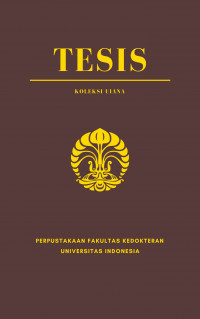Tesis
Korelasi Rasio Asupan Asam Lemak Omega-3/Omega-6 dan Kadar Asam Lemak Omega-3 Membran Eritrosit dengan Massa Otot Pada Usia Lanjut di Panti Wreda = Correlations of Omega-3 and Omega-6 fatty acids intake ratio and omega-3 fatty acids erythrocyte membrane levels with muscle mass among institutionalized elderly.
Penurunan massa otot pada usia lanjut menimbulkan fenomena sarkopenia. Salah satu penyebabnya adalah proses inflamasi. Gaya hidup sedentary juga dapat menyebabkan sarkopenia, terlihat dari prevalensi sarkopenia yang lebih tinggi pada usia lanjut di panti wreda dibandingkan komunitas. Asam lemak omega-3 diketahui memiliki efek anti inflamasi, namun penelitiannya terhadap massa otot masih menunjukkan hasil yang beragam, disebabkan oleh asupan asam lemak omega-6 yang tinggi sehingga rasio asam lemak omega-3/omega-6 menjadi rendah. Penelitian potong lintang ini bertujuan untuk mengeksplorasi korelasi antara rasio asupan asam lemak omega-3/omega-6 dan kadar asam lemak omega-3 dengan massa otot pada usia lanjut di lima panti wreda yang terdaftar di Kota Tangerang Selatan. Penelitian ini melibatkan 101 usila yang didapatkan menggunakan proportional random sampling. Rasio asupan asam lemak omega-3 dan omega-6 dinilai menggunakan food record 3x24 jam dan food frequency questionnaire semikuantitatif, kadar asam lemak omega-3 membran eritrosit diukur menggunakan gas chromatography-mass spectrometry, dan pemeriksaan massa otot menggunakan bioelectrical impedance analysis. Analisis korelasi menggunakan uji Spearman. Didapatkan rerata usia subjek adalah 75,5 ± 7,6 tahun dengan 73,3% subjek adalah perempuan, 40,6% berpendidikan tamat SD/ SMP, 92,1% tidak merokok, 48,5% memiliki aktivitas fisik sedentary, 37,6% memiliki indeks massa tubuh normal, 65,3% tidak dislipidemia, 76,2% tidak diabetes melitus, 73,3% tidak memiliki penyakit kardiovaskuler, namun 68,3% memiliki hipertensi. Rasio asupan asam lemak omega3/omega-6 yang didapatkan adalah 0,09 (0,05-0,22) menggunakan food record dan 0,08 (0,05-0,23) menggunakan FFQ semikuantitatif. Nilai tengah kadar asam lemak omega-3 membran eritrosit untuk ALA=10,06 (4,9-24,9) µg/mL, EPA=14,6 (5,06-81,02) µg/mL, DHA=115,5 (20,6-275,09) µg/mL, dan total omega-3=144,1 (89,3-332,1) µg/mL. Nilai tengah massa otot subjek adalah 35,5 (22,8-63,5) kg. Hasil penelitian ini menunjukkan tidak terdapat korelasi antara rasio asupan asam lemak omega-3/omega-6 dengan massa otot baik menggunakan food record (r = -0,180, p = 0,072) maupun FFQ semikuantitatif (r = 0,012, p = 0,902), dan tidak terdapat korelasi antara kadar ALA, EPA, DHA, dan total asam lemak omega-3 membran eritrosit dengan massa otot (r = -0,026, p = 0,794; r = 0,009, p = 0,927; r = -0,064, p = 0,527; dan r = -0,023, p = 0,817).
Kata kunci: Asam Lemak, Massa Otot, Usia Lanjut.
The phenomenon of muscle mass deterioration appeared in the elderly called sarcopenia and one of the reasons was the inflammatory process. A sedentary lifestyle also causes sarcopenia, making the prevalence of sarcopenia in the institutionalized elderly higher than in the community. Omega-3 fatty acids are known to have anti-inflammatory effects, but the effects towards muscle mass are still conflicting due to the high intake of omega6 fatty acids making the ratio of omega-3/omega-6 fatty acids low. This cross-sectional study aimed to explore the correlations of omega-3/omega-6 fatty acids intake ratio and omega-3 fatty acids erythrocyte membrane levels with muscle mass among the elderly in five registered nursing homes in South Tangerang City. This study involved 101 elderly from the proportional random sampling method. The ratio of omega-3 and omega-6 fatty acids intake was assessed using 3-days food record and semi-quantitative food frequency questionnaire (SQ-FFQ). Moreover, omega-3 fatty acids erythrocyte membrane levels were measured using gas chromatography-mass spectrometry and muscle mass were examined using bioelectrical impedance analysis. We used Spearman analysis to investigate the correlation. The mean age of the participants was 75.5 ± 7.6 years. Most of the participants were female (73.3%), graduated from elementary/junior high school (40.6%), did not smoke (92.1%), had sedentary physical activity (48.5%), had normal body mass index (37.6%), did not have dyslipidemia (65.3%), did not have diabetes mellitus (76.2%), did not have cardiovascular disease (73.3%), but had hypertension (68.3%). Furthermore, the median value of omega-3 and omega-6 fatty acid intake ratio was 0.09 (0.05 – 0.22) using a 3-days food record and 0.08 (0.05 – 0.23) using SQ-FFQ, the median value of omega-3 erythrocyte membrane levels for ALA = 10.06 (4.9-24.9) µg/mL, EPA = 14.6 (5.06 – 81.02) µg/mL, DHA = 115.5 (20.6 – 275.09) µg/mL, total omega-3 = 144.1 (89.3 – 332.1) µg/mL, and the median value of muscle mass were 35.5 (22.8 – 63.5) kg. In conclusion, we did not find strong correlation between omega3/omega-6 fatty acids intake ratio and muscle mass using either 3-days food records (r = -0.2, p = 0.07), or SQ-FFQ (r = 0.01, p = 0.9), and no strong correlations found between ALA, EPA, DHA, total omega-3 fatty acids erythrocyte membrane levels and muscle mass (r = -0.03, p = 0.8; r = 0.01, p = 0.9; r = -0.06, p = 0.5; and r = -0.02, p = 0.8), respectively.
Keywords: Fatty acids, Muscle mass, Elderly.
- Judul Seri
-
-
- Tahun Terbit
-
2020
- Pengarang
-
Nita - Nama Orang
Sri Widia A. Jusman - Nama Orang
Diyah Eka Andayani - Nama Orang - No. Panggil
-
T20013fk
- Penerbit
- Jakarta : Program Studi Magister Ilmu Gizi., 2020
- Deskripsi Fisik
-
xviii, 138 hal; ill; 21 x 30 cm
- Bahasa
-
Indonesia
- ISBN/ISSN
-
-
- Klasifikasi
-
NONE
- Edisi
-
-
- Subjek
- Info Detail Spesifik
-
-
| T20013fk | T20013fk | Perpustakaan FKUI | Tersedia |


Masuk ke area anggota untuk memberikan review tentang koleksi